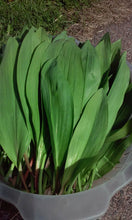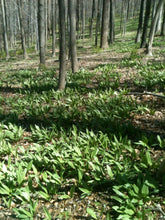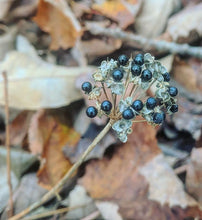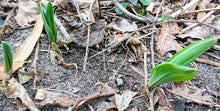Wild Ramps (SE Pennsylvania Ecotype)
Regular price
$4.25
Sale
Allium tricoccum
Origin: Southeastern Pennsylvania
Improvement status: Wild
Seeds per pack: ~45
BOTANICAL SAMPLE - NOT GERMINATION TESTED
Life cycle: Perennial
Ramps are a much-treasured harbinger of Spring. Often the first green vegetable to sprout after the long winter — and a healthy one at that — they are so beloved that many towns up and down Eastern North America celebrate a "Ramp Festival" upon their arrival. They have recently become a highly sought-after luxury item too, available for sometimes $25 per pound at high-end greengrocers from Brooklyn to Chicago (which actually got its name from the Algonquin word for ramps!) — leading to major fears of over-harvesting. Yet for generations these were considered "peasant food," and they are typically foraged from the wild rather than cultivated. The main reason they are rarely grown is simply a lack of patience: like other perennial vegetables, ramps from seed take years to reach full maturity — and need a deciduous woodland habitat in which most farmers are unused to cultivating crops. They also divide quite slowly. The rule of thumb when foraging a hidden, private patch of ramps is to only take — at most! — up to 1/7 of the plants each year, to allow for regeneration and maintenance of the patch. If a patch is being foraged by others, take far less. To be absolutely sustainable, a forager should only take one of the bright green, broad leaves (which are unusual for Alliums) and not disturb or remove the bulbs at all. Both the leaves and the pale, slender bulbs can be consumed though. Ramps have a milder, more delicate flavor than other wild onions, but are more pungent and flavorful than cultivated leeks or scallions. The best ramps boast notes of garlic as well.
GROWING TIPS: According to C. Dale Hendricks, who collected these seeds in the hills and dales west of Philadelphia, ramp seeds are typically "double dormant," which means they require two winters before germination. Sometimes they will germinate before winter, and the root will grow all winter, but the first leaves won't appear until Spring. Other times they will send out roots and shoots all at once in the Spring. Dale says the best way to get these seeds to germinate soon is to keep them vacillating between cooler and warmer temperatures, such as by keeping them in the fridge for a few days, then removing them, and so on. In milder climates, such as the Southeast, you might want to simply plant them on arrival and let nature take its course. But even with Dale's expert treatment, these seeds may still take a year or more to germinate. Once they do, resist the urge to harvest any for at least five years, and eventually you will be richly rewarded with a secret ramp patch of your own. (Choose a moist deciduous forest or the shadiest corner of your garden — but do not plant where the shade is provided by evergreen trees or shrubs, as ramps are spring ephemerals that rely on the dappled sun of spring before the tall trees leaf out.) For those who live in areas where this is a native plant, it is a great candidate for "guerilla gardening," or "reverse wildcrafting": find some good habitat, plant them, and keep coming back every year to check on them. Ramps are overharvested and therefore under threat across their range, so future generations will thank you.
The Maine Organic Farmers and Gardeners Association (MOFGA) published this excellent piece on growing ramps from seed which we highly recommend reading.
NOTE: Due to limited seed quantity, and stratification requirements, we have decided to not perform a germination test, so these are being sold as a "botanical sample."








